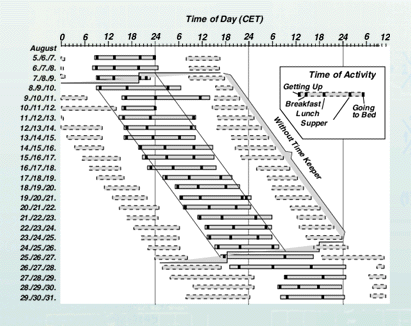The two-way division of the total spectrum which is marked by the horizontal double line in illustration 1 is important. In the long wave field there are such rhythmic functions – together with daily, weekly, monthly and annual rhythms – for which in the geophysical-cosmic or socio-ecological environmental order there exist appropriate rhythmic processes, even if these are of a very different nature.
The organism is by no means passively subjected to these external temporal orders. They do not simply control its functions from the outside, but it has more or less internalized these orders and is capable of producing them itself. This has been clearly proven in trials with complete environmental isolation in bunkers and caves (cf. illustration 4).
The outside environmental rhythms, however, have the effect of time keepers, they have a synchronizing, i.e. phase-regulating effect and in this way secure the cosmic ordered basis for the entire time structures of the organism and their correct environmental classification.
This applies especially to daily and yearly rhythms, while the weekly and monthly rhythms of the organism have already, to a large extent, become independent, obviously in the course of a general progressive temporal emancipation of civilized human beings from the natural temporal orders.

